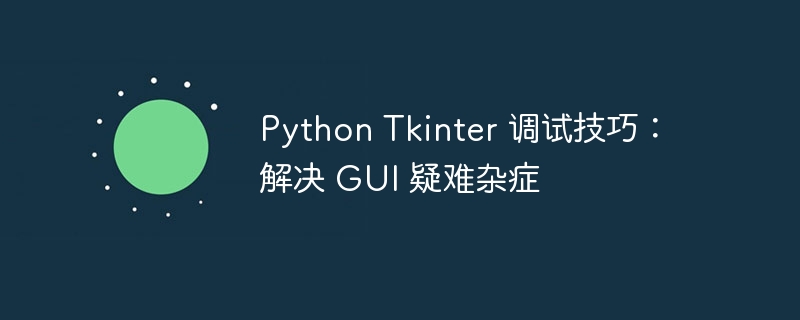Home >Backend Development >Python Tutorial >Python Tkinter Debugging Tips: Solving GUI Troubleshooting
Python Tkinter Debugging Tips: Solving GUI Troubleshooting
- WBOYWBOYWBOYWBOYWBOYWBOYWBOYWBOYWBOYWBOYWBOYWBOYWBforward
- 2024-03-24 09:26:11972browse

Basic debugging steps
- Check code syntax: Check the code carefully for grammatical errors and spelling errors. Tkinter GUI applications are particularly sensitive to syntax errors.
- Use print statements: Use print statements in key lines of code to print variable values and debugging information. This helps you understand the execution flow of your code and the state of variables.
- Set a breakpoint: Set a breakpoint in the IDE to stop execution at a specific line of code. This allows you to inspect variable values and trace program flow at runtime.
- Use the debugger: Python provides a debugger that allows you to step through your code, set breakpoints and inspect variables.
GUI specific debugging tips
- Using Tkinter event tracking: Tkinter provides an event tracking mechanism that allows you to print information about control events such as button clicks and keyboard input. This is helpful for debugging user interaction issues.
- Check control properties: Use the control's "get" method to check the control's current property values, such as text, color, and status. This helps identify misconfigurations or invalid values.
- Debugging using layout managers: Use Tkinter's layout manager to organize GUI elements. Make sure to use the correct layout managers and set their properties correctly to avoid layout issues.
- Check the parent-child relationship: There is a parent-child relationship between Tkinter controls. Make sure the control is correctly inserted into the parent control, if not it will result in unpredictable behavior of the GUI element.
Advanced debugging skills
- Use logging: Add logging logging statements to your code to capture error, warning, and information messages. This helps you identify problems and provides contextual information when problems occur.
- Use profiler: Use profilerTools to analyze the performance of your code and identify bottlenecks. This helps you optimize your GUI application and improve its responsiveness.
- Use unit tests: Writing unit tests for GUI components Tests can help you isolate and test individual controls and functionality. This helps catch errors at an early stage and improves code quality.
in conclusion Tkinter GUI debugging can be a challenge, but by using the appropriate techniques and strategies, you can effectively troubleshoot problems and ensure the stability of your application. Following these steps and suggestions can help you diagnose and fix GUI problems quickly, saving time and effort.
The above is the detailed content of Python Tkinter Debugging Tips: Solving GUI Troubleshooting. For more information, please follow other related articles on the PHP Chinese website!
Statement:
This article is reproduced at:lsjlt.com. If there is any infringement, please contact admin@php.cn delete

